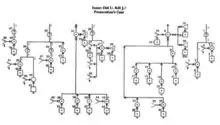Wigmore chart
A Wigmore chart (commonly referred to as Wigmorean analysis) is a graphical method for the analysis of legal evidence in trials, developed by John Henry Wigmore.[1][2] It is an early form of the modern belief network.[3]

After completing his Treatise in 1904, Wigmore "became convinced that something was missing." He set up a system for analyzing evidence that consisted of lines, used to represent reasoning, explanations, refutations, and conclusions; and shapes which represent facts, claims, explanations, and refutations.[4]
Although Wigmore taught his analytic method in the classroom during the early 20th century, the Wigmore chart was all but forgotten by the 1960s.[4] Recent scholars have rediscovered his work and used it as a basis for modern analytic standards.[5]
See also
References
- Anderson et al. (2005), Chapter 5
- Wigmore (1913), (1937)
- Kadane & Schum (1996) pp66-76
- Goodwin, Jean (2000). "Wigmore's Chart Method". Informal Logic. 20 (3). doi:10.22329/il.v20i3.2278.
- Anderson, Terence; Twining, William (1998). Analysis of Evidence: How to Do Things with Facts Based on Wigmore's Science of Judicial Proof (2nd ed.). Northwestern University Press. ISBN 9780810116764.
Bibliography
- Anderson, T.; et al. (2005). Analysis of Evidence (2nd ed.). Cambridge: Cambridge University Press. ISBN 0-521-67316-X.
- Kadane, J. B. & Schum, D. A. (1996). A Probabilistic Analysis of the Sacco and Vanzetti Evidence. New York: Wiley. ISBN 0-471-14182-8.
- Wigmore, J. H. (1913). "The problem of proof". Illinois Law Review. 8 (2): 77–103.
- Wigmore, J. H. (1937). The Science of Judicial Proof: As Given by Logic, Psychology and General Experience and Illustrated in Judicial Trials (3rd ed.). Boston: Little, Brown.